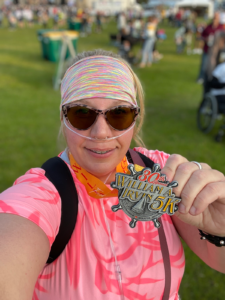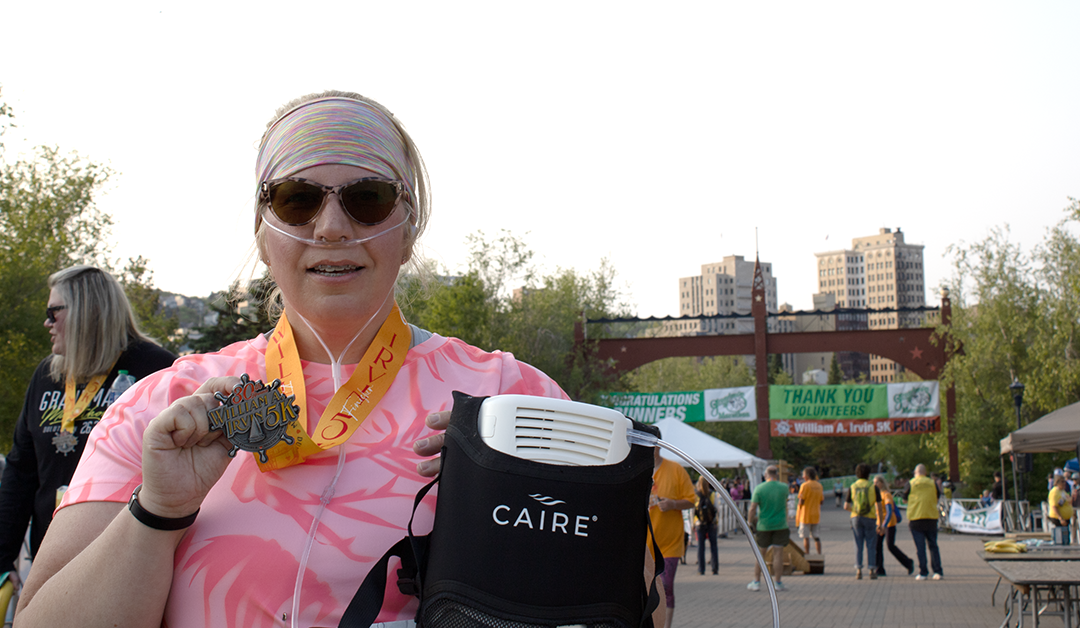Contributed by Natalie Haglund, consultant to CAIRE Inc.~
In July 2016 I started pulmonary rehab. Interstitial lung disease had slowed me down a lot, and one of the medications I had been put on (to try to manage and slow down the progression of my lung disease), had caused significant weight gain. I wanted to manage that, feel the benefits of moving my body, as well as gain back some of the strength and muscle I had lost. I wanted to be active again.
Once I started pulmonary rehab, I was immediately in love with it. For several reasons. One, there were other people like me that carried around supplemental oxygen and had trouble breathing. I didn’t realize how much I mentally needed that commonality within a group of people. We had different types of lung diseases, but we had similar experiences with shortness of breath, decreasing oxygen levels, and what caused those things to happen. Throughout the program, we learned about each other and made friendships. One friend I am still in contact with. Since pulmonary rehab, she had a double lung transplant and continues to inspire me.
Another reason I loved going to pulmonary rehab was because of the exercise. My pace was turtlelike at best, but I was doing it! Our stations consisted of the treadmill, hand bike, and the Nu-Step. My progress was slow but steady. One day while I was walking on the treadmill, I announced to the group that I wanted to do a 5K someday. Keep in mind that I was using supplemental oxygen 24/7 at that time, and my treadmill pace was 2.0 at best. I really didn’t know if that would be an attainable goal, but it was something I wanted to consider.
Towards the end of my pulmonary rehab program, I had a routine pulmonology checkup. My routine tests showed some improvement in my lung function and my supplemental oxygen was discontinued. What an amazing day!!! My healthcare team and I believe several factors contributed to this. Medications had done a lot of work, but pulmonary rehab also played a part. At that point I was a few weeks from graduating from the rehab program. When I did complete the program, the final six-minute walk test showed definite improvement. I had the respiratory therapist write down my results from when I started the program and my results from that day. It was the best Post-it note of my life. It states: Initial – 1146.8 feet, 2L, 97%, Final – 1361 feet, RA, 97%. Interpretation of the “shorthand”: feet = the distance I walked, 2L references that I was on oxygen at 2 LPM, RA means breathing room air (no supplemental O2), and the percentage was my oxygen saturation. I still have that Post-it note.
 At that point I was still thinking about walking a 5K race. I wasn’t ready to make a commitment yet, and I took the winter months to think about how I could go about it to set myself up for success. Things I took into consideration were time of year, as weather can affect my breathing. Hot, humid weather is something I try to avoid. The course is also a factor. The flatter the better. Inclines cause my lungs to work harder, which makes me short of breath and my oxygen saturation decreases. I didn’t want to do the race alone, so I had to recruit a friend or two. I also wanted time to “train” for the race. I obviously wasn’t going to break any race records, but I wanted to complete it in time that I could do safely and feel good about. I got the okay to proceed from my healthcare team, along with parameters where I need to keep my oxygen saturation. I picked a local race that took place in October 2017.
At that point I was still thinking about walking a 5K race. I wasn’t ready to make a commitment yet, and I took the winter months to think about how I could go about it to set myself up for success. Things I took into consideration were time of year, as weather can affect my breathing. Hot, humid weather is something I try to avoid. The course is also a factor. The flatter the better. Inclines cause my lungs to work harder, which makes me short of breath and my oxygen saturation decreases. I didn’t want to do the race alone, so I had to recruit a friend or two. I also wanted time to “train” for the race. I obviously wasn’t going to break any race records, but I wanted to complete it in time that I could do safely and feel good about. I got the okay to proceed from my healthcare team, along with parameters where I need to keep my oxygen saturation. I picked a local race that took place in October 2017.
I had a lot of help and encouragement from friends. I trained on a treadmill for about six months. A couple of weeks before the race I practiced walking with a friend on part of the actual racecourse, so I had some familiarity. Two other friends joined me for the actual race, one of whom happens to be a paramedic and the other a nurse. The weather was beautiful on race day. I was excited and nervous. I had music in my ears and a pulse oximeter in my pocket. I had two goals. To finish, and to try to finish in under an hour. The first half of the race went well, but the second half felt more challenging. To keep myself going mentally, I thought about all I had navigated and overcome related to my lung disease up until that point. I thought about everyone who supported and encouraged me. I channeled the frustration I felt having to live with this lung disease. I made it across the finish line and was handed a medal. Smiles and tears followed. I did it! I felt like I showed my lungs who was boss! Later, when I got my official chip time (results) — 55:54. Well under an hour. I felt like a superhero.
It took my lungs a couple of days to recover from the race, and I had definitely caught a bug. The race bug. I was ready to sign up for another 5K, and I did. From September 2017 to now I have completed one 2 mile race, fourteen 5K races, and one 10K race. Results have varied as to my completion times, but finishing is always the victory for me. My most recent 5K was in June 2023. I now must wear supplemental oxygen when I race, but I’ll keep signing up for them as long as I can. My healthcare team is aware of my participation, and I stay within the parameters that they set so I don’t get myself into (respiratory) trouble.
Do you have a goal you’d like to achieve? Does it seem like a big feat? Think about how to make it manageable. If it involves physical activity, discuss it with your healthcare team. Enlist family or friends to help you. Remember that you don’t have to be in first place to be victorious. Be your own hero.
Natalie Haglund, 50, diagnosed with Idiopathic NSIP (a type of interstitial lung disease), lives in northern Minnesota where she works as a Licensed Practical Nurse (LPN) in the operating room. She enjoys photography, hiking, concerts, crafty projects, and time with her 23-year-old daughter, friends and family.
If you have been prescribed oxygen therapy, learn more about CAIRE by visiting www.caireinc.com/patients or by calling 1-800-482-2473 to talk to an oxygen advisor.
The contents of this blog post are not intended to substitute for professional medical advice. Please consult your physician for personalized medical advice. When using any oxygen therapy device please consult the applicable product instructions for use for product indications, contraindications, warnings, precautions, and detailed safety information.

